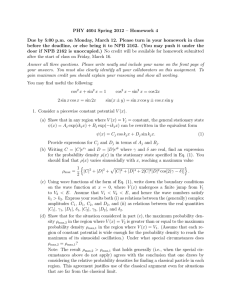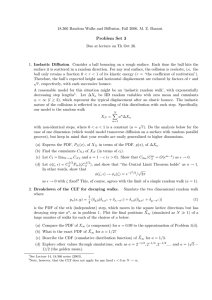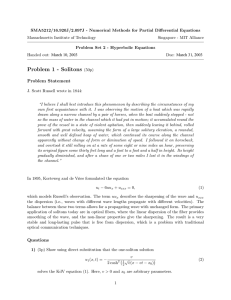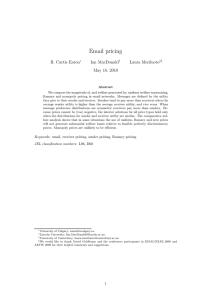PHY 4604 Fall 2009 – Homework 4
advertisement
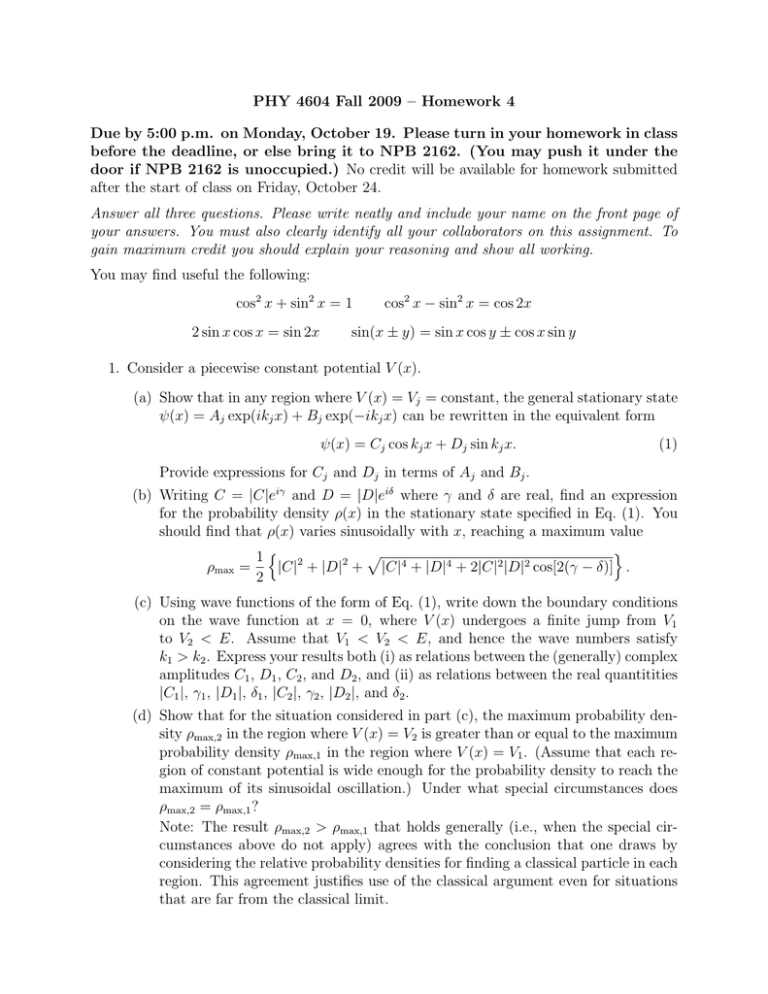
PHY 4604 Fall 2009 – Homework 4 Due by 5:00 p.m. on Monday, October 19. Please turn in your homework in class before the deadline, or else bring it to NPB 2162. (You may push it under the door if NPB 2162 is unoccupied.) No credit will be available for homework submitted after the start of class on Friday, October 24. Answer all three questions. Please write neatly and include your name on the front page of your answers. You must also clearly identify all your collaborators on this assignment. To gain maximum credit you should explain your reasoning and show all working. You may find useful the following: cos2 x + sin2 x = 1 2 sin x cos x = sin 2x cos2 x − sin2 x = cos 2x sin(x ± y) = sin x cos y ± cos x sin y 1. Consider a piecewise constant potential V (x). (a) Show that in any region where V (x) = Vj = constant, the general stationary state ψ(x) = Aj exp(ikj x) + Bj exp(−ikj x) can be rewritten in the equivalent form ψ(x) = Cj cos kj x + Dj sin kj x. (1) Provide expressions for Cj and Dj in terms of Aj and Bj . (b) Writing C = |C|eiγ and D = |D|eiδ where γ and δ are real, find an expression for the probability density ρ(x) in the stationary state specified in Eq. (1). You should find that ρ(x) varies sinusoidally with x, reaching a maximum value o p 1n 2 ρmax = |C| + |D|2 + |C|4 + |D|4 + 2|C|2 |D|2 cos[2(γ − δ)] . 2 (c) Using wave functions of the form of Eq. (1), write down the boundary conditions on the wave function at x = 0, where V (x) undergoes a finite jump from V1 to V2 < E. Assume that V1 < V2 < E, and hence the wave numbers satisfy k1 > k2 . Express your results both (i) as relations between the (generally) complex amplitudes C1 , D1 , C2 , and D2 , and (ii) as relations between the real quantitities |C1 |, γ1 , |D1 |, δ1 , |C2 |, γ2 , |D2 |, and δ2 . (d) Show that for the situation considered in part (c), the maximum probability density ρmax,2 in the region where V (x) = V2 is greater than or equal to the maximum probability density ρmax,1 in the region where V (x) = V1 . (Assume that each region of constant potential is wide enough for the probability density to reach the maximum of its sinusoidal oscillation.) Under what special circumstances does ρmax,2 = ρmax,1 ? Note: The result ρmax,2 > ρmax,1 that holds generally (i.e., when the special circumstances above do not apply) agrees with the conclusion that one draws by considering the relative probability densities for finding a classical particle in each region. This agreement justifies use of the classical argument even for situations that are far from the classical limit. 2. A particle of mass m moves in the one-dimensional potential V (x) = −V0 aδ(x), where V0 > 0 is an energy and a > 0 is a length scale. The bound state wave function for this problem was discussed in class; see also Eq. (2.129) of Griffiths (where α ≡ V0 a). (a) Find hV i, the expectation value of the potential in the bound state. (b) Find hT i, the expectation value of the kinetic energy in the bound state, where T̂ = −(~2 /2m)∂ 2 /∂x2 . Verify that hT i + hV i = E, the energy of the bound state. Hint: In order to obtain the correct value for hT i, you must take into account the fact that the slope of the wave function undergoes a jump at x = 0. 3. A particle of mass m moves in the one-dimensional potential V (x) = V0 Θ(x) − V1 aδ(x), where V0 and V1 are positive energy scales, a > 0 is a length scale, and Θ(x) is the Heaviside or step function: 0 for x < 0, Θ(x) = 1 for x > 0. This potential describes a delta-function well located right at a jump in the background potential. (a) Write down the form of wave function for a bound state of energy E < 0 in the regions x < 0 and x > 0. You may leave in your answer any unknown amplitude that may have a nonzero value in a physically acceptable state. You should define any other symbol that doesn’t appear in the statement of the problem. (b) By applying the appropriate boundary conditions, obtain an equation relating the bound-state energy E to other quantities defined above. Express your answer in the form f (E) = constant. (c) Use your answer to (b) to determine the range of V1 over which a bound state exists. (d) Find the bound-state energy E in closed form. You should be able to eliminate all square roots from the equation you found in (b) by squaring both sides, then carrying some terms from one side to the other side before squaring again. As a check, for V0 = 0, the energy should reduce to E = E1 = −ma2 V12 /(2~2 ), the standard result for a pure delta-function potential V (x) = −aV1 δ(x). (e) Now consider stationary state wave functions of energy E > V0 . Apply the appropriate boundary conditions to construct the wave function describing a rightward moving particle incident from the far left, plus any reflected and transmitted products. (f) Find the transmission probability T (E) for E > V0 .
